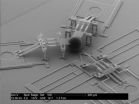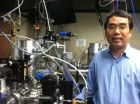(Press-News.org) WASHINGTON D.C. May 13, 2014 -- The ability to transfer a gene or DNA sequence from one animal into the genome of another plays a critical role in a wide range of medical research—including cancer, Alzheimer's disease, and diabetes.
But the traditional method of transferring genetic material into a new cell, called "microinjection," has a serious downside. It involves using a small glass pipette to pump a solution containing DNA into the nucleus of an egg cell, but the extra fluid can cause the cell to swell and destroy it—resulting in a 25 to 40 percent cell death rate.
Now, thanks to the work of researchers Brigham Young University, there's a way to avoid cell death when introducing DNA into egg cells. In Review of Scientific Instruments, the team describes its microelectromechanical system (MEMS) nanoinjector, which was designed to inject DNA into mouse zygotes (single-cell embryos consisting of a fertilized egg).
"Essentially, we use electrical forces to attract and repel DNA—allowing injections to occur with a tiny, electrically conductive lance," explained Brian Jensen, associate professor in the Department of Mechanical Engineering at Brigham Young University. "DNA is attracted to the outside of the lance using positive voltage, and then the lance is inserted into a cell."
The MEMS nanoinjector's lance is incredibly small and no extra fluid is used with this technique, so cells undergo much less stress compared to the traditional microinjection process.
This ability to inject DNA into cells without causing cell death leads to "more efficient injections, which in turn reduces the cost to create a transgenic animal," according to Jensen.
One of the team's most significant findings is that it's possible to use the electrical forces to get DNA into the nucleus of the cell—without having to carefully aim the lance into the pronucleus (the cellular structure containing the cell's DNA). "This may enable future automation of the injections, without requiring manual injection," Jensen says.
It may also mean that injections can be performed in animals with cloudy or opaque embryos. "Such animals, including many interesting larger ones like pigs, would be attractive for a variety of transgenic technologies," said Jensen. "We believe nanoinjection may open new fields of discovery in these animals."
As a next step, Jensen and colleagues are performing injections into cells in a cell culture using an array of lances that can inject hundreds of thousands of cells at once. "We expect the lance array may enable gene therapy using a culture of a patient's own cells," he noted.
INFORMATION:
The article "A Self-Reconfiguring Metamorphic Nanoinjector for Injection into Mouse Zygotes" by Quentin T. Aten, Brian D. Jensen, Sandra H. Burnett, and Larry L. Howell will be published in the journal Review of Scientific Instruments on Tuesday, May 13, 2014 (DOI: 10.1063/1.4872077). After that date, it will be available at: http://scitation.aip.org/content/aip/journal/rsi/85/5/10.1063/1.4872077
The paper's first author Quentin Aten participated in this research while at Brigham Young University. He is now working at Nexus Spine LLC.
ABOUT THE JOURNAL
The journal Review of Scientific Instruments, which is produced by AIP Publishing, presents innovation in instrumentation and methods across disciplines. See: http://rsi.aip.org/
MEMS nanoinjector for genetic modification of cells
Researchers from Nexus Spine LLC and Brigham Young University have developed new, high-tech device for transferring DNA into cells
2014-05-13
ELSE PRESS RELEASES FROM THIS DATE:
Why athletes are more likely to need pacemakers in old age
2014-05-13
A new study by The University of Manchester has shed light on why athletes are more likely to have abnormal heart rhythms.
Elderly athletes with a lifelong history of training and competing in endurance events like marathons, triathlons and iron man challenges can have heart rhythm disturbances, known as arrhythmias.
The Manchester research in rodents, funded by the British Heart Foundation, shows molecular changes in the heart's pacemaker occur in response to exercise training.
The finding, reported in Nature Communications, overturns the commonly held belief that ...
Study: state VAMS don't reflect content, quality of teachers' instruction
2014-05-13
WASHINGTON, D.C., May 13, 2014—New research published online today in Educational Evaluation and Policy Analysis (EEPA), a peer-reviewed journal of the American Educational Research Association, finds weak to nonexistent relationships between state-administered value-added model (VAM) measures of teacher performance and the content or quality of teachers' instruction. Based on their results, the authors question whether VAM data will be useful in evaluating teacher performance and shaping classroom instruction.
VIDEO: Co-author Morgan S. Polikoff discusses key findings ...
Ultrafast laser technique developed to observe electron action
2014-05-13
University of Central Florida physicist Zenghu Chang has done it again. For a third time this year, his research group has published an article in a Nature journal.
This time, Chang and his team have developed a new ultrafast light source for observing electron motion in molecules – made up of nuclei and electrons – at the point before the nuclei start to move. By being able to observe what actually happens, scientists can begin to understand how an electron interacts with other electrons, which may help improve the efficiency of solar cells.
"The charge migration that ...
Released prisoners are more likely to suffer early death
2014-05-13
Men who have been incarcerated and released are more than twice as likely to die prematurely as those who have not been imprisoned, according to a new study published by Georgia State University criminologist William Alex Pridemore.
Former prisoners are more likely to die early from infectious and respiratory diseases, drug overdoses and homicides. Causes of this "mortality penalty" include increased exposure to diseases like TB and HIV, the prolonged stress of the prison environment, the disruption of important social bonds and, upon release, the struggle to reintegrate ...
Forgiving a wrong may actually make it easier to forget
2014-05-13
We're often told to "forgive and forget" the wrongs that we suffer – it turns out that there may be some scientific truth behind the common saying. A study from researchers at the University of St. Andrews in Scotland shows that the details of a transgression are more susceptible to forgetting when that transgression has been forgiven.
The findings are published in Psychological Science, a journal of the Association for Psychological Science.
"It is well established that learning to forgive others can have positive benefits for an individual's physical and mental health," ...
Signal Fire in New Mexico
2014-05-13
Firefighters are currently battling the Signal Fire in the Gila National Forest in New Mexico. The fire was reported by the Signal Peak Lookout Tower Sunday (May 11) in the afternoon and is located approximately 15 miles north of Silver City. It is currently estimated to be 4,700 acres. The Southwest Area Incident Management Team assumed command of the fire Monday at 6:00 p.m. The cause of the fire is thought to be human either a careless camper or arson, but the investigation is still ongoing. Residents in the vicinity of Signal Peak have evacuated. The firefighters ...
Screening is 'not effective' in the fight against domestic violence
2014-05-13
One in three women around the world have experienced physical or sexual violence from a partner. Although domestic violence is associated with a range of adverse health impacts, even after the abuse has ended, it is not easily identified by health care professionals, prompting some countries, notably the United States, to introduce screening programmes in healthcare settings. A new study, published online by the BMJ today [13 May], has found no evidence to support domestic violence screening.
Researchers from the Universities of Bristol and Melbourne, La Trobe and Columbia ...
Surgery study shows worse health, more problems and higher costs among Medicaid patients
2014-05-13
ANN ARBOR, Mich. — Surgery patients covered by Medicaid come into their operations with worse health, do worse afterward, stay in the hospital longer and find themselves back in the hospital more often than those covered by private insurance, a new analysis by University of Michigan Medical School researchers finds.
In fact, people with Medicaid coverage were twice as likely as other patients to have certain health risk factors before they had surgery, the researchers report in JAMA Surgery. They also had many more emergency operations, experienced two-thirds more complications ...
New cancer immunotherapy aims powerful T cells against tumors
2014-05-13
Deadly skin cancers in mice shrank in response to a new treatment that may complement other "immunotherapies" developed recently to boost the body's own defenses against disease threats, according to a new study published by UC San Francisco researchers in the May 2014 edition of the Journal of Experimental Medicine.
Using a mouse version of a human drug that is popular for treating osteoporosis, the UCSF researchers discovered a way to manipulate the thymus, a gland situated at the base of the neck above the heart, to alter its activity so that some of the specialized ...
First year student publishes monsoon study
2014-05-13
A first year Environmental Science student at The University of Nottingham Malaysia Campus (UNMC) has had a literature review of the Southeast Asian monsoon published in the academic journal Geoscience Frontiers. Her research concluded that future climate warming could lead to a 15 day delay in the monsoon onset in Southeast Asia by the start of the next century.
Yen Yi Loo investigated how global and regional temperature and rainfall anomalies affect rainfall patterns and the South East Asian Monsoon. She also highlighted how increased rainfall intensity in the last ...
LAST 30 PRESS RELEASES:
The Ceramic Society of Japan’s Oxoate Ceramics Research Association launches new international book project
Heart-brain connection: international study reveals the role of the vagus nerve in keeping the heart young
Researchers identify Rb1 as a predictive biomarker for a new therapeutic strategy in some breast cancers
Survey reveals ethical gaps slowing AI adoption in pediatric surgery
Stimulant ADHD medications work differently than thought
AI overestimates how smart people are, according to HSE economists
HSE researchers create genome-wide map of quadruplexes
Scientists boost cell "powerhouses" to burn more calories
Automatic label checking: The missing step in making reliable medical AI
Low daily alcohol intake linked to 50% heightened mouth cancer risk in India
American Meteorological Society announces Rick Spinrad as 2026 President-Elect
Biomass-based carbon capture spotlighted in newly released global climate webinar recording
Illuminating invisible nano pollutants: advanced bioimaging tracks the full journey of emerging nanoscale contaminants in living systems
How does age affect recovery from spinal cord injury?
Novel AI tool offers prognosis for patients with head and neck cancer
Fathers’ microplastic exposure tied to their children’s metabolic problems
Research validates laboratory model for studying high-grade serous ovarian cancer
SIR 2026 delivers transformative breakthroughs in minimally invasive medicine to improve patient care
Stem Cell Reports most downloaded papers of 2025 highlight the breadth and impact of stem cell research
Oxford-led study estimates NHS spends around 3% of its primary and secondary care budget on the health impacts of heat and cold in England
A researcher’s long quest leads to a smart composite breakthrough
Urban wild bees act as “microbial sensors” of city health.
New study finds where you live affects recovery after a hip fracture
Forecasting the impact of fully automated vehicle adoption on US road traffic injuries
Alcohol-related hospitalizations from 2016 to 2022
Semaglutide and hospitalizations in patients with obesity and established cardiovascular disease
Researchers ‘listen in’ to embryo-mother interactions during implantation using a culture system replicating the womb lining
How changing your diet could help save the world
How to make AI truly scalable and reliable for real-time traffic assignment?
Beyond fragmented markets: A new framework for efficient and stable ride-pooling
[Press-News.org] MEMS nanoinjector for genetic modification of cellsResearchers from Nexus Spine LLC and Brigham Young University have developed new, high-tech device for transferring DNA into cells



